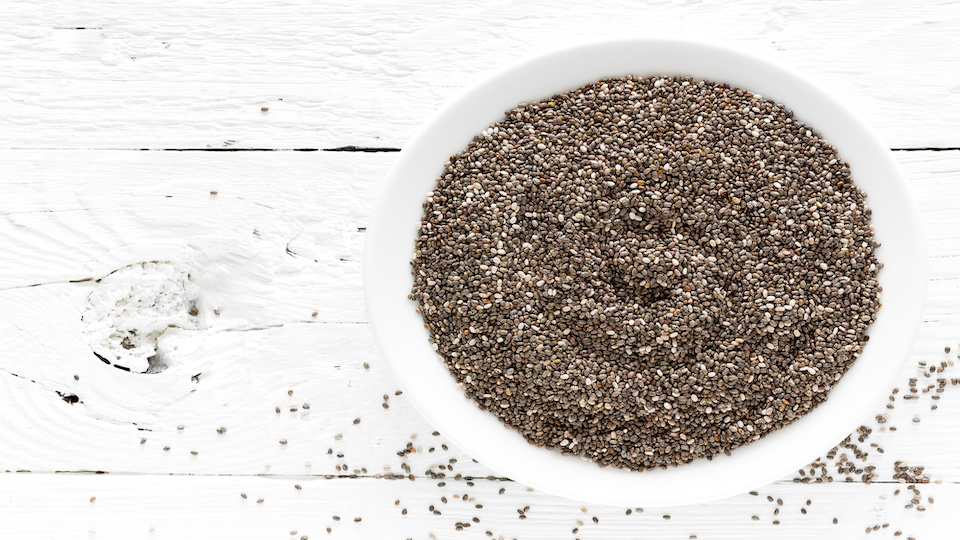Chia seeds are tiny black/white seeds of the plant Salvia hispanica belonging to the same family as mint and basil. They have a long history of cultivation in South America, where they were a staple food of ancient civilizations.
Chia simply meant ‘strength’ to the Mayans, who consumed a special drink called ‘Iskiate,’ made by mixing chia seeds with sweetened lime juice. It was supposed to increase stamina and endurance while engaging in strenuous activities. Spanish invaders of South America supposedly banned the crop in order to break the spirit and strength of the natives.
Somewhere along the way, this highly nutritious seed fell out of popular use and remained obscure for centuries, its cultivation limited to small pockets south of Mexico. All this changed when it was rediscovered and repositioned as a superfood, owing to its rich nutritional profile.
Rich in fiber, omega 3 fatty acids, and B1, B2, and B3 vitamins, 2 tablespoons (28 grams) of chia provides nearly a third of the recommended daily dose of magnesium, manganese, phosphorus, and calcium. This is probably the most energy-dense food you can grow within a limited space.
Growing Chia
Chia can be grown in the garden all year long in USDA Zones 10-12. In Zones 8 and 9, it is grown as a summer crop.
Sowing seeds
Anyone who has had a chia pet knows how easily these tiny seeds sprout. The same chia seeds you buy for consumption can be used, and not much preparation is required. Just scatter the seeds among your vegetables or ornamentals after scratching the soil surface ever so lightly.
Water daily with a fine nozzle. The seeds will sprout within a week. Regular watering is essential during the early phases, but mature plants don’t need much water. They can even handle drought.
Thinning out
The chia seedlings will need thinning out several times until only the healthiest seedlings remain. One plant per square feet will give each one space to spread as they grow and branch out. If you’re dedicating an entire area to chia, even closer spacing is fine, as the seedlings will grow together into a dense stand 5-6 feet high, choking out any weeds.
Fertilizing
Chia plants are not heavy feeders. They do very well on their own in well-draining soils with medium fertility. Top dressing with good quality compost or well-rotted manure once a month will give a boost to the growing plants. An application of Vermicompost or worm castings is especially beneficial.
Flowering
The long, green flower heads of chia bear many individual flowers in succession. These tiny purplish blue flowers spill out of little pockets, which will hold the maturing seeds eventually.
Harvesting the seeds
Chia plants have a 120-day life cycle. Spring planted chia will be ready for harvest in summer, and those planted in late summer to early fall should be ready before winter frosts arrive. You will know it’s time to harvest when the majority of flowers have fallen off.
If you have only a few plants, gather the seeds by tipping individual flower heads into a brown paper bag. This method is not viable for a larger patch. It’s better to cut the entire tops of the plants just before the seeds fully mature and start falling off their little pockets.
Spread the cut tops on newspapers laid in shade/indoors and allow to dry naturally. The seeds will continue to mature during this time. Shake out the seeds onto a clean bed sheet and blow away the debris with a hand-held fan. Dry well and store.
Some ways to use your chia seeds
- Soak chia seeds in fruit juice
To make a wholesome drink, add a tablespoon of chia seeds to any fruit juice. Keep it aside until the seeds absorb water and swell. Chill and drink. This appetite suppressing drink is ideal for dieters.
- Make chia fresco
This is as close as you can get to the energy drink Iskiate of the Mayans. Spike two cups water with freshly squeezed juice of a lemon and mix in 2 tablespoons chia seeds. Add sugar, honey or maple syrup to sweeten the drink. Stir well and drink.
- Thicken your smoothies and milkshakes
Having no significant taste or flavor of its own, chia seeds will go with any type of smoothies, whether sweet or savory. Blend one or two tablespoons with the other ingredients of your drink to make it pleasantly thick and extra nutritious.
- Garnish cereals and salads
Chi seeds give a nutritional and flavor boost to cereals and salad. Use them generously.
- Make chia sprouts and microgreens
Place chia seeds in a container lined with kitchen towels and add just enough water to dampen them. Cover with plastic wrap and leave on the kitchen counter. Chia seeds readily germinate, and the sprouts can be used fresh in salads, added to soups or eaten as a snack.
- Sprinkle over baked goods
Chia seeds can be used on top of baked items just like sesame or poppy seeds. Before baking bread and cookies, sprinkle chia seeds over them.
- Make your own chia pets
Any old doll can be transformed into a chia pet. Just dip the head in water and roll on a bowl of chia seeds. Use a fine spray of water twice a day to keep the seeds hydrated until they sprout, and then water once daily.
-Susan Patterson




